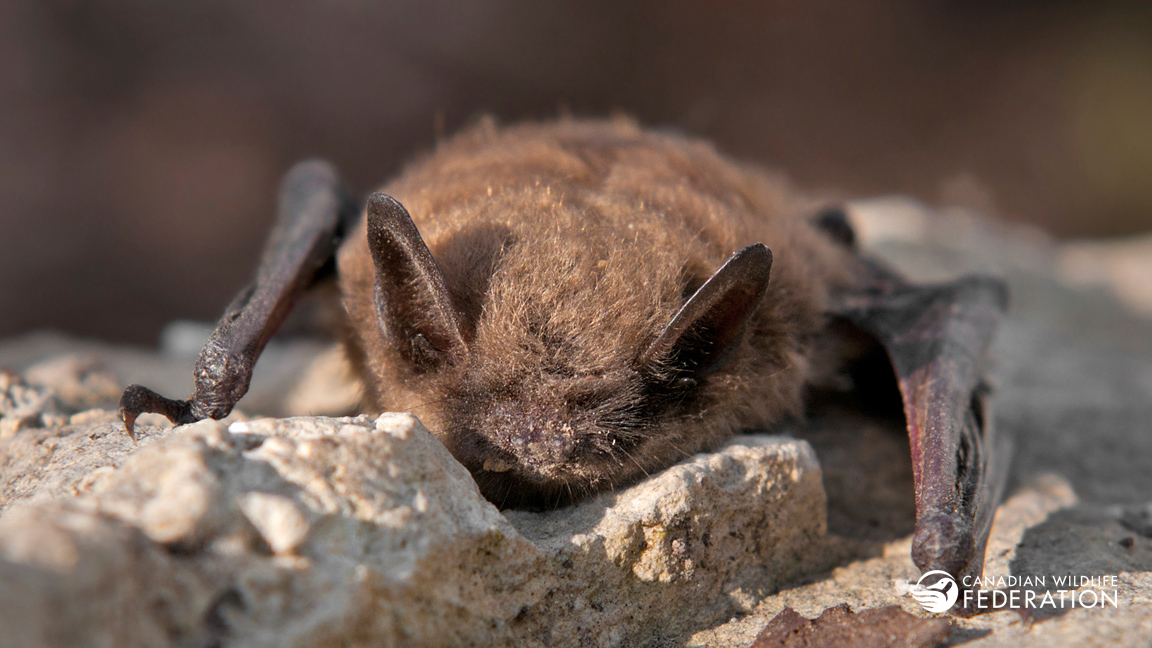
Animals often feature prominently in human culture, with specific aspects of their biology emphasized over others. What traits do you think of first when you think of bats?
All bats belong to the order Chiroptera, which is derived from ancient Greek and means ‘hand wing’. The most common bats found in North America and Europe belong to a group called ‘Vespertiliones’ which is derived from the latin ‘vesper’, meaning ‘the evening’. These are just two aspects of bat biology that are highlighted. Traits that are often emphasized in western culture include bats’ association with darkness and underground caverns (portals to underworld), avoidance of light, drinking blood, mysterious habits, and bats’ erratic flight (crazy).
Since bats are active during the night, and humans cannot see well at night and so have a hard time observing them, bats are often portrayed as mysterious and associated with the dark and unknown. At this time of year you often see bats associated with witches, other beings that fly at night, as in the witches scene from Macbeth:
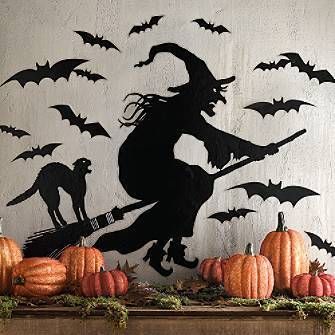
“Double, double toil and trouble;
Fire burn, and caldron bubble.
Fillet of a fenny snake,
In the caldron boil and bake;
Eye of newt, and toe of frog,
Wool of bat, and tongue of dog…”
Although only three species of bat (out of more than 1,300 species) drink blood, bats are often associated with Dracula. In Greek mythology, bats are associated with the underworld- Persephone and Hades. The bat is a god of death in Mayan culture.
The Egyptians used a bat to signify a man of small means and weak power. Batman chose his costume to inspire fear in enemies, and this was also one of the inspirations for the use of bats in heraldry, such as in France, England, Spain, Switzerland, and Ireland. On coats of arms bats are usually displayed with wings open and facing the observer. Other traits bats are supposed to represent in heraldry include watchfulness, wakefulness, and vigilance. The ability to stay awake all night is a good trait to have for a night watchman or a pilot! Here is the heraldry of the Baxter family in Scotland:
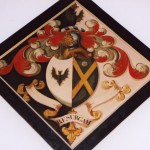
(source)
Other heraldry featuring bats can be found here.
Some cultures view bats differently from the traditional western stance. Gypsies consider bats good luck, and the ancient kingdom of Macedonia thought bats the luckiest of all animals. Due to their longevity bats are sometimes associated with wisdom. In the Chinese language the word for bat is fu, which also is the name of the character meaning ‘happiness’. The figure of a bat stands for happiness or good luck and is frequently seen worked into designs in Chinese handicraft. Two bats written upon a gift signify good wishes from the donor, and a talisman widely used in China consists of a disk about the size of a dollar, enclosing the symbol of life (a tree with roots and branches), and surrounded by five bats with spread wings, facing in.
This talisman of the five bats – or wu-fu – is worn for the five great happinesses (five good fortunes, five blessings) sought by all people: health, prosperity, long life, good luck, and a desire for virtue or, as sometimes put, tranquility. Below is a typical example with five jade bats. The red color symbolizes joy. This particular design of having five bats surrounding the Chinese character shou became quite popular during the Ming and Qing Dynasties and is universally recognized by all Chinese as wu fu peng shou or “five fortunes surround longevity”.
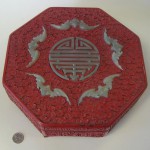
(source)
Below is another example, this one made of stone as an ‘open work’ charm.
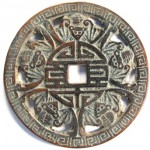
(source)
In Chinese art bats (representing male traits) are also often paired with peaches (representing female traits) as before peaches were first cultivated in China approximately 5,000 years ago, bats were the primary means of dispersing peach seeds from eating the fruit. Below is a Qing dynasty porcelain dish from the Yongzheng period (1723–35).

(source)
More examples of bats on beautiful pieces of Chinese art can be found here.
Bats are sometimes considered creatures with a double nature: half bird, half beast. In old English bats were called a reremouse, and in Anglo-Saxon bats were ‘hrere-mus’, the fluttering-mouse. Seventh century sources state that the bat is a bird, but unlike other birds, it is four-legged and resembles a mouse and makes a squeaking sound. This double nature is sometimes featured in the mythologies of native peoples. Below is an aboriginal tale from Australia featuring bats called flying foxes. It explains how night came to be separated from day.

The grey-headed flying fox in Australia, one of six species of flying fox that live there. (source)
“At the beginning of time, birds and animals often gathered together for feasts and dancing. There was much vying among the tribes at these festive occasions. The Cockatoo, who was quite vain, was casually talking to the Eagle-hawk, the leader of the bird tribes, and he noted that the birds were better performers than the animals. The Eagle-hawk agreed. In addition to his vanity, the Cockatoo was also a bit of a gossip and he soon had told many of his bird friends that the Eagle-hawk had said that birds were better than animals. Before long, the word spread and soon the Kangaroo, the leader of the animal tribes, heard what the birds were saying. He went to the Eagle-hawk to protest and asked for an apology. The Eagle-hawk was stubborn and, confronted in this way, he refused. Soon, the Kangaroo and Eagle-hawk were quarrelling. Tempers rose, others joined in, and soon blows were struck and a battle began. As the battle raged, the only ones who were uncertain about the dispute were the Flying Fox and the Owl. They conferred and decided that the sensible thing to do was to wait and join the winning side. So they watched the war from the shade of a tree.
The birds and animals fought back and forth as their fortune ebbed and flowed; weapons flashed were dulled with blood. By and by, the animals were pushed back and the birds, cheered by their success, redoubled their efforts. At this point, the Owl shouted to the Flying Fox, ‘Come on, we are bird-men’ and the two conspicuously joined the side of the birds. However, the Kangaroo had wisely mustered a fresh band of highly-trained warriors in the rear and soon the course of the battle swayed to the animals. The Flying Fox hissed at the Owl that he had been wrong. The Owl shrugged and replied, ‘Do not worry,’ as he turned and began bludgeoning the birds with his club. Reluctantly, the Flying Fox followed the Owl’s example.
Presently, the Kangaroo and the Eagle-hawk met in combat. Both were so exhausted from the fighting that they could scarcely raise their clubs. The Eagle-hawk said, ‘What are we really fighting about, Kangaroo? If I have offended you with my boasting, I am sorry.’ The fighting stopped and everyone made up and became friends again. The Flying Fox and the Owl quickly realized the awkwardness of their position, having switched sides in the heat of the battle. To avoid the scorn of their fellow creatures, they went off to hide in the bush. As they went, the light paled and soon the darkness was impenetrable. They did not know that Yhi, the Great Ruler, had been grieved by the fighting among the tribes and had hidden the light as punishment. The Flying Fox and the Owl were puzzled by the darkness, as sunset was many hours away, but neither was distressed because they were both quite comfortable in the darkness. The other creatures, however, soon began to wail because they could not see to gather food or find their way home. Presently, they decided to start fires and were able to find some food within the dim glow of their campfires.
The birds and animals were soon gathered in council to discuss what to do about the darkness. The Flying Fox and Owl were in hiding and, therefore, did not attend. The Lizard was sent to fetch then as the creatures thought that they might be able to help solve the dilemma. Eventually, the Lizard found the Flying Fox and the Owl and asked that they come back with him to the council fires. The Owl refused and said that he was quite comfortable in the darkness. The Flying Fox, feeling guilty for his actions, said he would come to the meeting. Once there, he confessed that he had been overly influenced by the deceitful Owl. All the creatures forgave him and asked him to help bring back the light. He said that since he was half bird and half animal that he was related to everyone and would help, but that all must remember that the darkness came because of the evil in their hearts. He then asked to borrow a boomerang. The Lizard gave him his. The Flying Fox threw the boomerang to the north and it flew straight and true around the earth and soon returned from the south. Next, he threw the boomerang to the east and it soon returned from the west. Just as he was about to throw the boomerang again, the Laughing Jack (Kookaburra) caught him by the shoulder and asked, ‘Why do you keep throwing the returning boomerang? Anyone can do that. What we need is the light to return’. The Flying Fox replied that he was cutting the darkness in two and that he would give the light to the creatures and keep the darkness for himself. He then threw the boomerang with a mighty heave to the west. If flew swiftly and, as it returned from the east, it brought with it the light. The birds and animals thanked him as he flew off into the departing night. The Owl was never forgiven and, to this day, when he flies out in the early dusk, he is mobbed by the other birds.”
Taken from: Hill JE and JD Smith. 1984. Bats: a natural history. University of Texas press. Austin. p.159-160.
Join our #HelpTheBats campaign and help break some common myths about bats. Sign up at HelpTheBats.ca.




7 comments
Although it was not through Canadian Wildlife Federation, my 8 year old did a fundraiser for the little brown bat.
In April she set up a display station for the afternoon and evening parent teacher/open house night. She had information on little brown bats, white nose syndrome and how to build a bat house. She collected much of this information from Canadian Wildlife Federation.
In May, for her 8th birthday, she asked her guests to give money instead of presents. The total from the two events, with a little extra from family, was $150. She donated this to Earth Rangers Little Brown Bat campaign. It may not have been Canadian Wildlife Federation, but her main reason was for the bats.
we the Indians treat Bat as a bad animal which carry so many varieties of viruses and other mites and arthropodes but as a nature lover i never believe in it and always love to protect The Indian fruit Bat , The Indian flying fox (Pteropus medius, formerly Pteropus giganteus) so listed as Least Concern (IUCN 3.1)[1].
but after Carona I am interested to work on find the other variety of viruses in these Bats